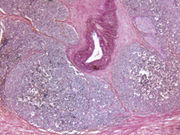No difference in other adverse pathological outcomes versus men undergoing immediate surgery
FRIDAY, Oct. 21, 2016 (HealthDay News) — For men with low-risk prostate cancer, those who enter active surveillance have higher grade of disease at prostatectomy, but no difference in other adverse pathological outcomes, compared to those undergoing immediate surgery, according to a study published in the November issue of The Journal of Urology.
Gregory B. Auffenberg, M.D., from the University of Michigan in Ann Arbor, and colleagues conducted a prospective cohort study involving two groups of patients with National Comprehensive Cancer Network low-risk prostate cancer who chose either initial active surveillance and went on to delayed prostatectomy or immediate prostatectomy. Radical prostatectomy Gleason scores, and rates of extraprostatic disease, positive surgical margins, seminal vesicle invasion, and lymph node metastases were compared between the groups.
The researchers found that 6 percent of 1,359 low-risk men choosing initial surveillance transitioned to prostatectomy during a median follow-up of 506 days. Men undergoing delayed surgery were more likely to have Gleason score 7 or greater disease (69.2 versus 48.8 percent; P = 0.004); however, they were no more likely to have positive margins, extraprostatic extension, seminal vesicle invasion, or lymph node metastases.
“Patients with low-risk prostate cancer who enter active surveillance have higher grade disease at prostatectomy compared to those undergoing immediate surgery,” the authors write. “However, the lack of difference in other adverse pathological outcomes suggests preservation of the window of curability.”
One author disclosed financial ties to Myriad Genetics.
Full Text
Copyright © 2016 HealthDay. All rights reserved.








